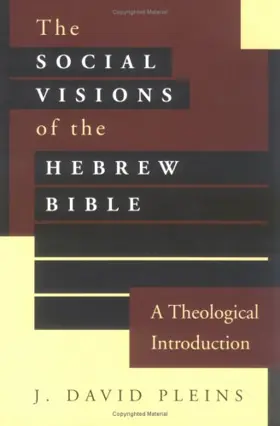

The Social Visions of the Hebrew Bible: A Theological Introduction
Pages
592
Publisher
Westminster John Knox
Published
2000
ISBN-13
9780664221751
This digital document is an article from Theological Studies, published by Theological Studies, Inc. on September 1, 2002. The length of the article is 881 words. The page length shown above is based on a typical 300-word page. The article is delivered in HTML format and is available in your Amazon.com Digital Locker immediately after purchase. You can view it with any web browser.
Citation Details
Title: The Social Visions of the Hebrew Bible: a Theological Introduction.(Brief Article)
Author: Gina Hens-Piazza
Publication: Theological Studies (Refereed)
Date: September 1, 2002
Publisher: Theological Studies, Inc.
Volume: 63 Issue: 3 Page: 601(2)
Article Type: Brief Article, Book Review
Distributed by Thomson Gale
Citation Details
Title: The Social Visions of the Hebrew Bible: a Theological Introduction.(Brief Article)
Author: Gina Hens-Piazza
Publication: Theological Studies (Refereed)
Date: September 1, 2002
Publisher: Theological Studies, Inc.
Volume: 63 Issue: 3 Page: 601(2)
Article Type: Brief Article, Book Review
Distributed by Thomson Gale
Reviews
Argues for a variety of ethical perspectives from different socio-historical settings within the Old Testament.
[Full Review]
Louisville: Westminster John Knox, 2001. Pp. xii + 592. Paper. $39.95. ISBN 0664221750. Mark J. Boda McMaster Divinity College, McMaster University Hamilton, ON L8S 4K1 Overview Pleins begins by situating himself within the history of ethical reflection using social-scientific analysis of the Hebrew Bible (Weber, Bizzell, Causse, Wallis), before outlining his own hermeneutical approach. Pleins seeks for a multidimensional �social reading� of the Hebrew Bible that incorporates sensibilities drawn from a variety of critical methodologies (including archaeology, social-scientific research, rhetorical and postmodern exegesis, and source analysis of the text). This is an ambitious project, for it incorporates critical methodologies that have often ignored or even undercut one another: ranging across the hermeneutical continuum from the world of the author through the world of the text to the world of the reader. This multifaceted approach guides Pleins in the �art of reading struggle-ridden texts.� Key, therefore, within Pleins�s view of the text of the Hebrew Bible is the belief that these texts have arisen out of social struggle within Israel�s society and that the various stream s of traditions (Deuteronomic, Yahwistic, Elohistic, Priestly) arose �i n large measure as products of movements in the early postexilic period,� making �attempts at recove ring the previous layers behind the texts� rather �problematic at best.
[Full Review]
In this comprehensive and well-informed study, Pleins draws together the best of biblicalmethodology and theological inquiry to produce a work that makes a major contributionto the field of biblical studies and offers readers new perspectives on a community’ssocial ethics that have pressing implications for creating a more just world order today.The volume consists of thirteen chapters that are systematically organized under thefollowing headings: Introduction (ch. 1); Law (ch. 2); Narrative (chs. 3–5); Prophets (chs.6–9); Poetry and Wisdom (chs. 10–12); and Conclusion (ch. 13).In his opening chapter, “Literature and Location,” Pleins outlines his social-scientificmethodological approach, uses the book of Jeremiah as a sample case study to elucidatehis approach, and evaluates the work of past scholars who have contributed to theconversation at hand (Weber, Bizzell, Causse, and Wallis). Pleins acknowledges theadvances made in biblical interpretation through the use of sociological methods andanalyses that, when applied to the biblical text, have helped to illumine the texts’ socialethics. At the same time, Pleins rightly warns against fitting the biblical text intocontemporary sociological theories and modern political biases. In his concludingcomments in this introductory chapter, Pleins states boldly that he is not convinced of theantiquity of J, E, D, P, and thus his approach will be to treat these sources in his book as“products of movements in the early postexilic period” (27).
[Full Review]

